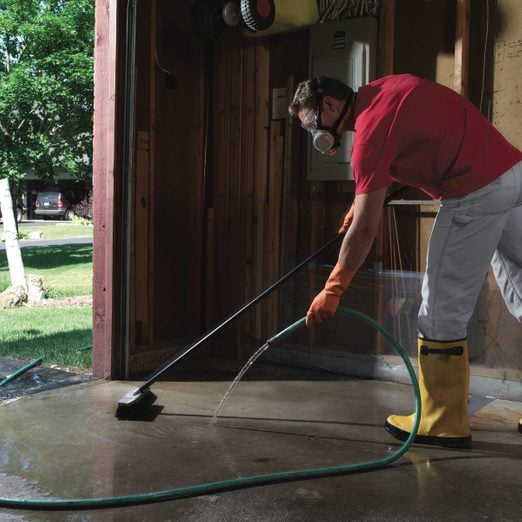How to Remove Paint from Concrete and Other Stains
Updated: Mar. 08, 2024
Remove oil and grease stains from concrete using TSP and other cleaners.
Multiple Days
Beginner
Less than $20
Introduction
Here's how to get out three of the toughest stains — oil, paint and rust. The secret is to draw the stain out of the concrete. You can easily do this in a weekend with simple tools and special products.Tools Required
- Dust mask
- Dustpan
- Knee pads
- Safety glasses
Materials Required
- abrasive cleanser
- Absorbent material (see “Buying Absorbent Materials&rdquo
- Muriatic acid
- paint stripper
You can’t scrub oil and grease stains away. The trick is to draw them up out of the concrete with trisodium phosphate (or a TSP substitute), water and an absorbent material.
Patience is the key. Old, long-neglected stains may require two or three applications for complete removal. And even then, some stains might still show, or the freshly cleaned area might look slightly different from the surrounding concrete.
Project step-by-step (13)
Mix Up an Absorbent Solution
- Pour 1 ounce of trisodium phosphate (or TSP substitute) and a cup of water into a small bucket and mix.
- Add about a cup of absorbent material and mix to make a creamy paste.
- Pro tip: Wear eye protection and rubber gloves.

Cover the Stain with the Solution
- Spread a 3/8-inch-thick layer of the paste over the stain.
- Allow the paste to dry for about 24 hours.
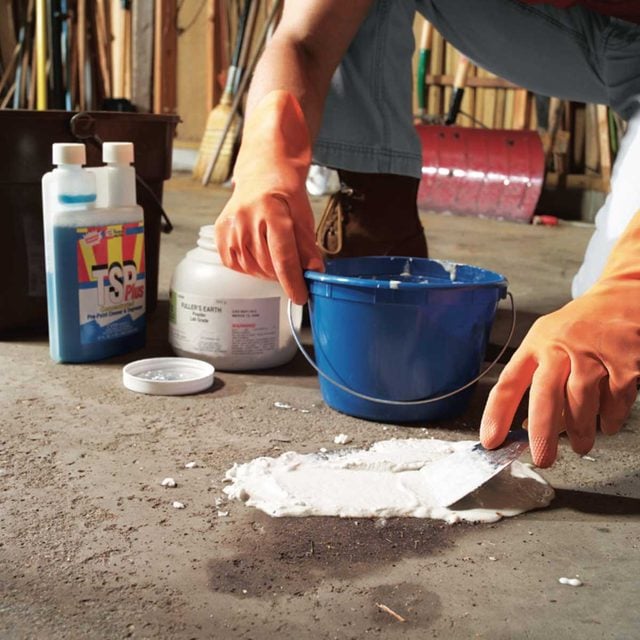
Scrape up the Dried Solution
- Scrape and brush off the powdery residue and either re-use it or dump it in the trash.
- Note: You can renew the powder residue with more TSP and water and reapply it for deeper cleaning.
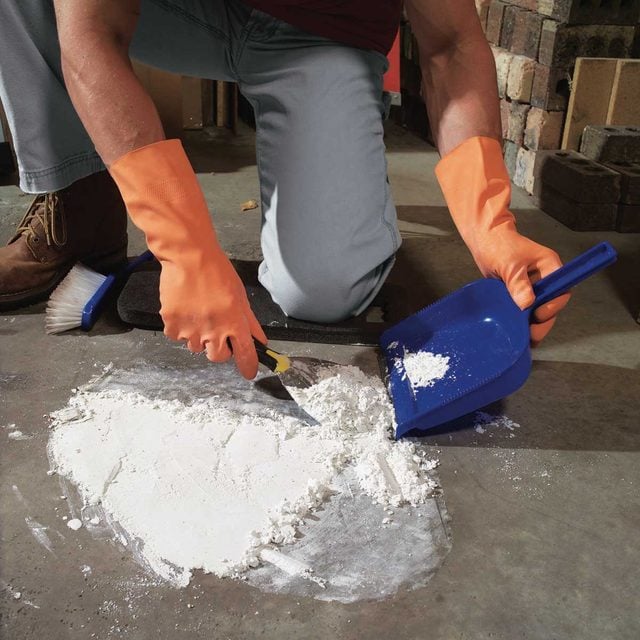
Scrub the Spot
- Scrub the area with water and a nylon brush.
- Pro tip: Use a nylon brush for cleanup. A wire brush may leave steel particles, which can cause rust stains.
- Rinse with a garden hose.
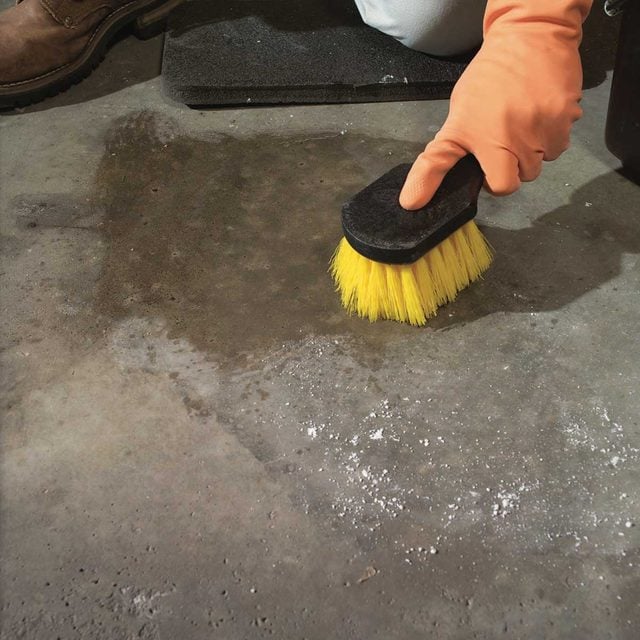
Repeat if Necessary
- Compare the stained area with the surrounding concrete.
- If necessary, repeat the process a second (and perhaps third) time to fully remove the stain.
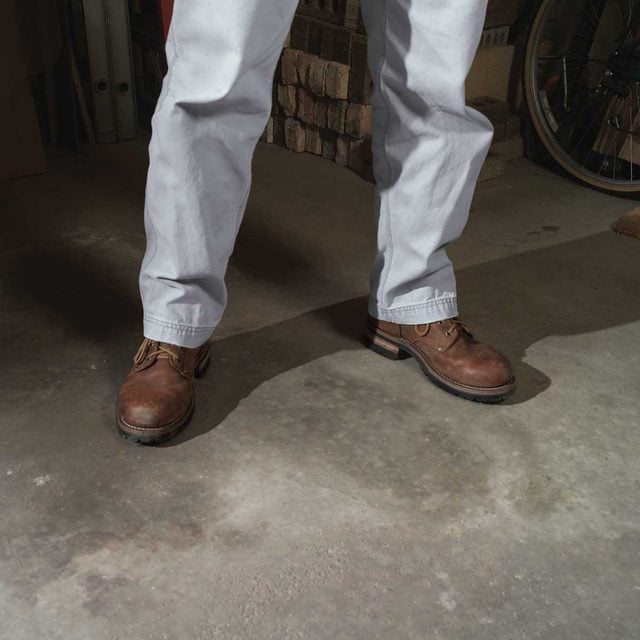
Buying Absorbent Materials
You have a variety of options for absorbent materials. For small stains, simply use baby powder or powdered talc. For larger stains, you’ll need a bulk material. One good choice is diatomaceous earth, sold as a filtering agent for swimming pools. It’s available from most pool supply stores.
Fuller’s Earth is a finely ground clay that also works well for making a paste. But it’s generally only available through chemical supply stores or mail order (www.sciencelab.com), and at $9 per pound, it’s expensive.
Cat litter is also a good absorbent; however, it’s too coarse to make a good paste unless you crush it into a powder. The same goes for the absorbent materials that are designed to soak up oil spills.
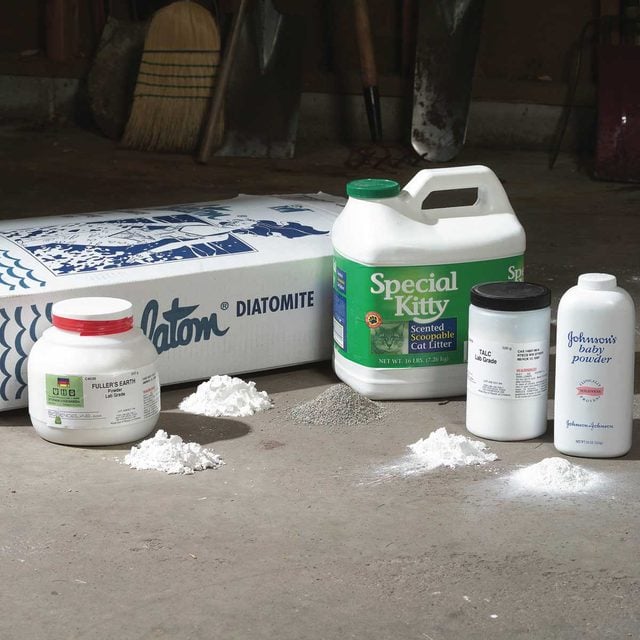
Apply the Stripper Solution
- Add paint stripper to an absorbent material to make a creamy paste.
- Note: If you’re working outdoors or in a detached garage (with the door open) and want fast results, you can use a methylene chloride-type stripper. The active ingredient will be listed on the can. But only use this in a well-ventilated area, and wear a respirator equipped with a fresh organic vapor cartridge. If you use a safer, slow-acting stripper, expect to wait several hours for it to work.
- Spread a 1/4- to 1/2-inch layer of paste over the paint stain.
- Wait 10 to 20 minutes while the stripper loosens the paint stain.

Remove the Solution
- Scrape off the paste and loosened paint with a plastic scraper.
- Let paint residue dry and toss it into the trash.
- Spread a second application if necessary.
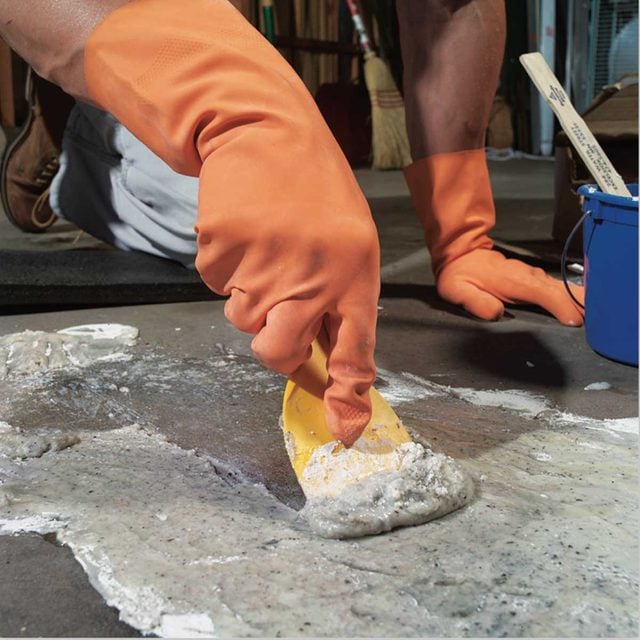
Scrub to Remove Embedded Particles
- Scrub area with a nylon brush, scouring powder and water to remove softened paint particles still stuck in the rough concrete.
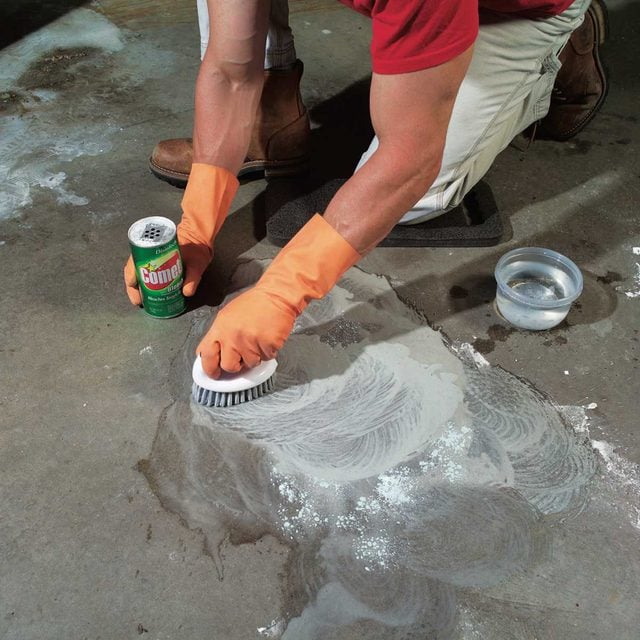
Rinse the Stain Area
- Rinse with plenty of water.
- Continue scrubbing with a nylon brush to finish cleaning.
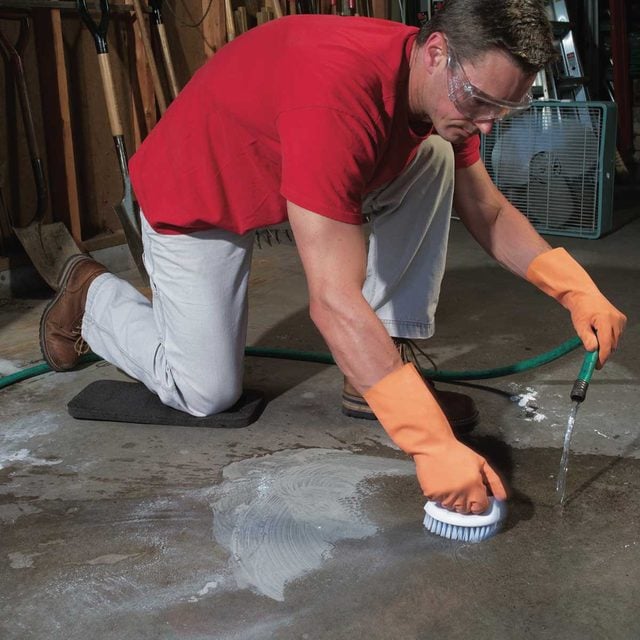
Dilute the Acid
-
- Note: Rust is really tough to get out, because no simple solvent will dissolve it. One effective way to remove rust from concrete is to dissolve the surface layer of concrete using a mild muriatic acid solution.
- Mask nearby materials with plastic covering to protect them from splashes.
- Add 1/4-cup of muriatic acid to 2 cups of water in a large, shallow plastic pan.
- Pro tip: Always pour acid into water, never water into acid.
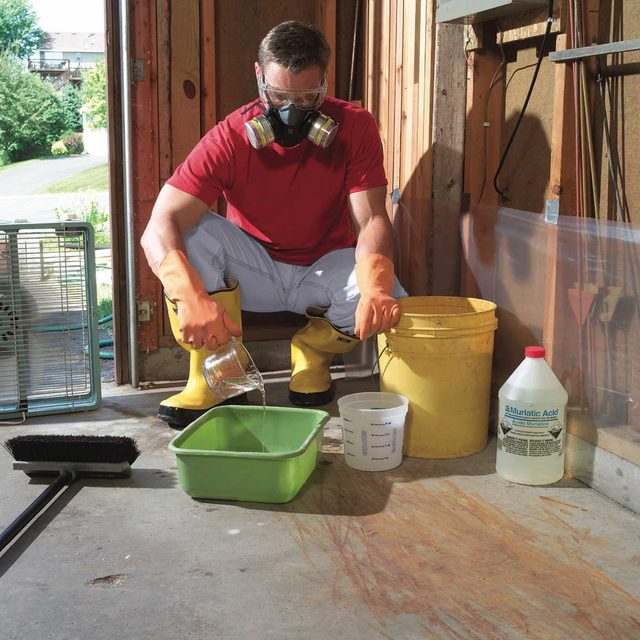
Apply the Acid with a Long-Handled Brush
- Spread the acid solution over the rusted area.
- Allow it to stand 5 minutes while the acid works.
- Reapply as needed, scrubbing more in stubborn areas.
- Note: The acid dissolves the cement in the surface layer of concrete. To minimize this etching process, start with a light application and observe the results. You’ll see the solution begin bubbling almost immediately. After the bubbling stops, scrub lightly with a long-handled nylon brush to see if the rust disappears.
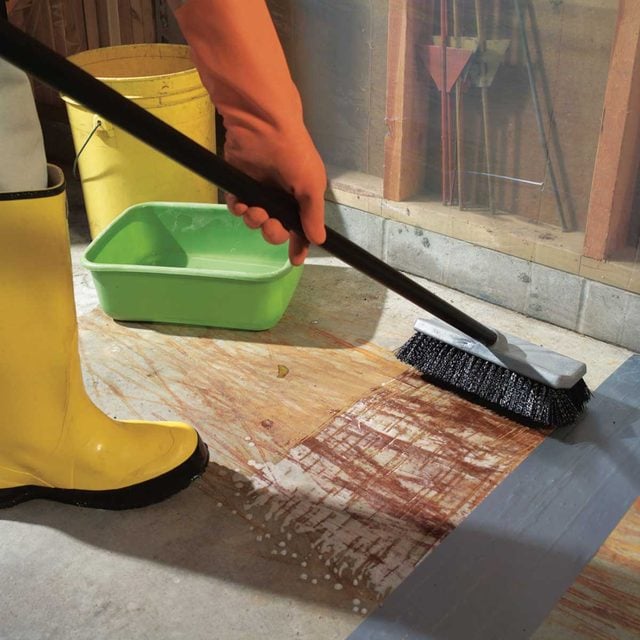
Rinse Carefully
- Rinse and scrub the area thoroughly, using plenty of fresh water to flush away all traces of residue.
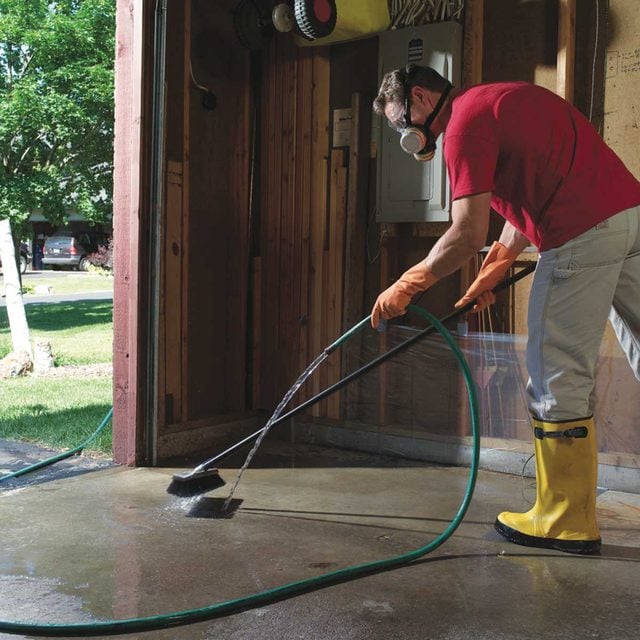
Seal the Concrete Once it Dries
- Once the surface is dry, seal your floor to reduce future staining.
- Note: Acid treatment leaves the surface of the concrete slightly rougher, like fine sandpaper.
- Pro tip: After cleaning with acid, play it safe. Thoroughly rinse your protective gear, wash your clothing and take a shower to make sure all traces are washed away.
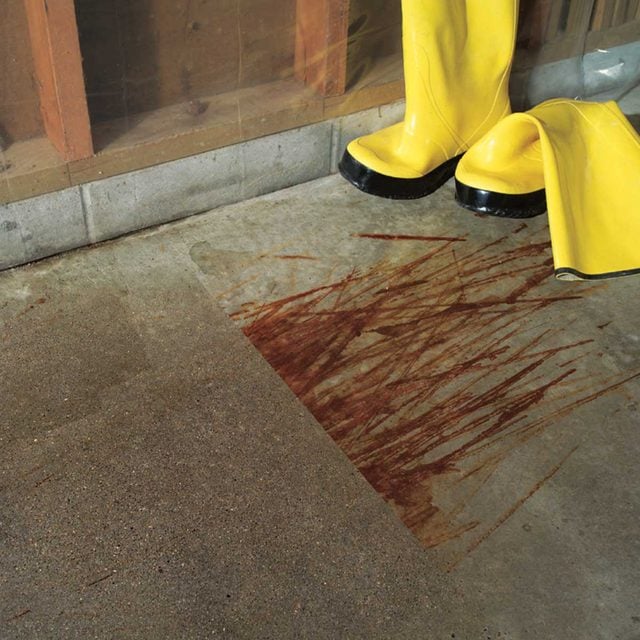
Muriatic Acid Safety
Working with an acid solution requires certain safety precautions:
- Wear rubber boots, goggles and rubber gloves. Also wear a respirator with a cartridge rated for acid vapor.
- Maintain good ventilation. Open doors and windows and add a fan for better air movement.
- Keep a 5-gallon bucket of clean water handy to quickly wash away any spill on bare skin.
- When mixing, always pour the chemical into the water, never the water into the chemical. And use only glass or plastic containers (no metal).
- Cover nearby areas with plastic to protect them from splashes.
- Read the manufacturer’s dilution guidelines on the label and follow them if they’re different from ours.
- Store extra acid out of reach of children.



















